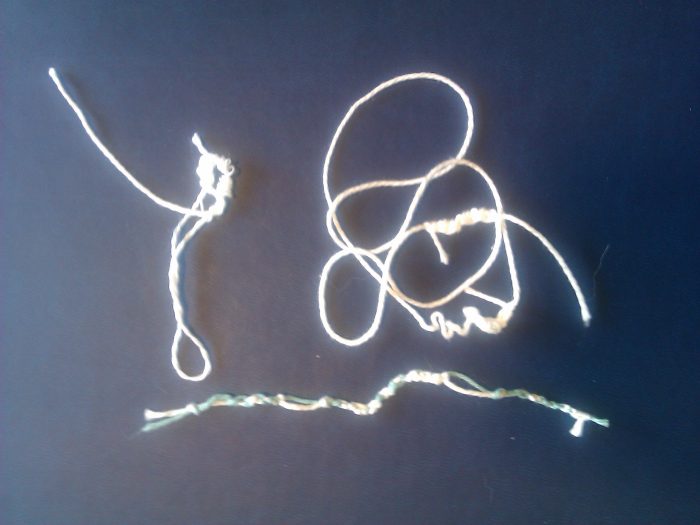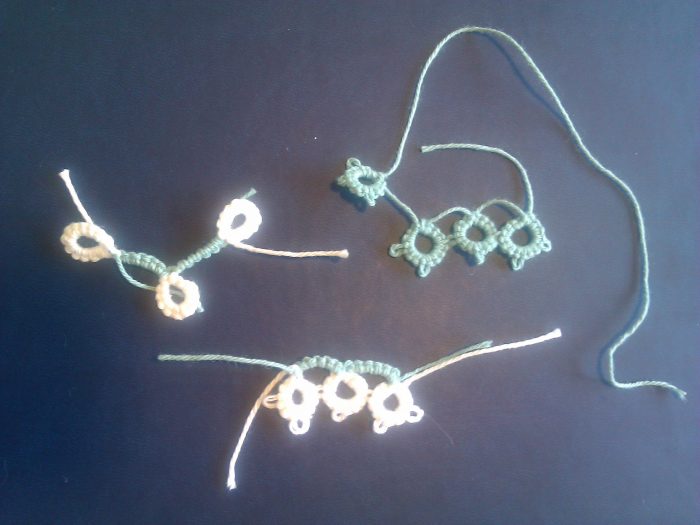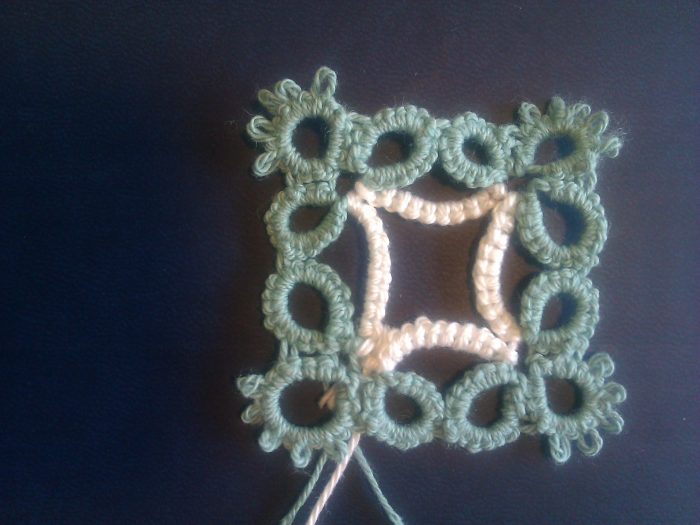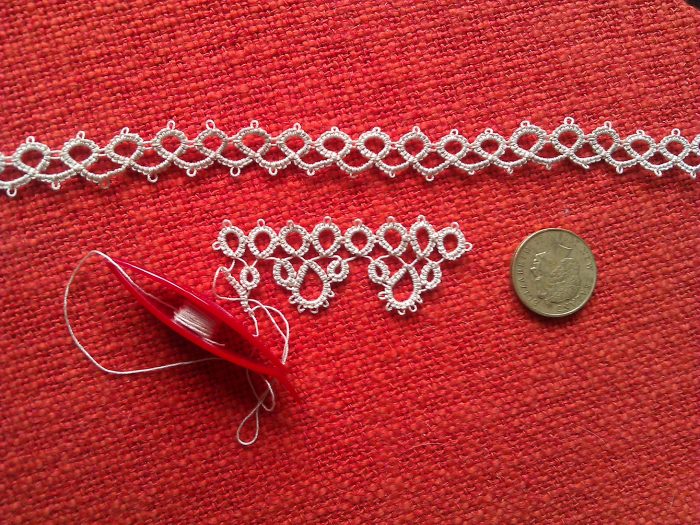Tatting is like squid. Hear me out (and please, do not attempt to tat with squid – the suckers never flow through the knot smoothly).
The similarity lies in the etymology, or rather the lack thereof. No one, not even the mighty Oxford English Dictionary, knows where the word squid comes from. And no one knows for certain why tatting is called tatting. It just is.
French calls it the frivolity, which seems a trifle harsh to me as it’s not any more frivolous than any other decorative handwork. German calls it little boat work, which refers to the shape of the shuttle but conjures up images of lazy afternoons drifting downstream in a punt, twiddling away.

Italian also calls it little boat work, or ‘the chatting’ – which works nicely if you’re tatting with friends – or simply ‘eyes’. The latter refers to the characteristic rings, but sounds a trifle creepy all the same. What are you doing there? Oh, just whipping up some eyes… Spanish calls it shuttle lace, which has the unusual merit of actually describing the thing it identifies.
But since tatting is the word that the English language seems to have settled on (language moves in mysterious ways, its blunders to perform), tatting let it be. And now, a tale of tatting – or perhaps more properly, a tale of a tatting obsession.
On the first day of February this very year, as I cruised the library catalogue looking for books with advice on how to create a housework routine without bullying oneself (a perennial problem) I happened by chance upon a book about tatting. Before I knew it, I was in the grip of a new obsession (what exactly is tatting?) and I found myself ogling tatting shuttles on Etsy before the day was out.
I’d never seen a tatting shuttle before, and would not have recognized one if it had bit me in the face. (Well-mannered shuttles never do this, it turns out.) But suddenly I found I wanted to learn how to tat. Badly. I had two sewing-machine bobbins, some cotton yarn, and a copy of Weldons Encyclopædia of Needlework. And what I produced was this:

Which, in case you are unsure, is not tatting. No, that is a poor-quality photograph of even poorer-quality tangled badly knotted thread. If it were mathematics, it would be Not Even Wrong.
Weldons Encyclopædia says “To one not accustomed to the work, it would naturally appear that the stitches should be formed by the thread which comes directly from the shuttle: [since that’s what’s being woven in and around the other thread] but this is not so. The stitches are actually made by the thread that is looped round the fingers of the left hand.” Hard to believe, but true.
Three days later, I viewed this video and finally got the hang of the double-stitch. By the 6th I’d learned to make rings. Rings on the same thread, even, although they aren’t sure how exactly they’re supposed to relate to each other. (Nor was I.)

By the 10th I’d got as far as making rings of one colour linked by chains of another, and even thriftily employed the head of a pin in lieu of a mini crochet hook to join one ring to another by means of picots.
Then I bought a book about tatting which, if not exactly the dernier cri of tatting books, is at least a rather more recent cri than Weldons. (The Complete Book of Tatting by Rebecca Jones, if you’re interested.) It is a slimmish vol, but has been a good deal dipped into and devoured of late.

The strange thing about this obsession is that unlike pretty much every other non-reading obsession I have ever had, it does not appear to have established a connection to my mad and reality-denying overambition. Tatting is for me the relatively unusual experience of doing something purely for the enjoyment of doing it, with no drive toward completion of fixed targets. No goal, no drive, just fun.
I have no rabid dreams of tatting myself an entire bedspread. You laugh? Weldons says “Medallions in tatting are very effective as pincushion tops, d’oyleys, etc., and joined together make handsome bedspreads, nightdress sachets, and so on.” I must confess that ‘nightdress sachet’ sounds to me like a capsule, which, when dropped into water, expands into a full-size but inconveniently soggy nightie. (Do not swallow with a glass of water, or indeed without one.)
By the middle of February I had acquired one plastic tatting shuttle and a modest quantity of crochet threads, all second-hand. (Yes, you tat with crochet threads. I’ve never crocheted with crocheted threads, but that’s beside the point.) I had also made a thing which was recognizably a thing, still with the use of my trusty sewing-machine bobbins. It took me a few days, but I did it.

Then I wound the ugliest of the crochet threads onto the shuttle (I figured I’d save the nice ones till I knew what I was doing) and returned the bobbins to sewing-machine duty. It took me a while to get used to the size of the shuttle – it’s only 6 1/2 centimetres long, but that’s still considerably larger than a bobbin – but I loved the way it didn’t unwind across the floor if I dropped it.
The obsession has continued more or less unabated for lo these seven weeks, during which time I’ve also done a good deal of mulling over the purchase of something in the shuttle line that wasn’t plastic. (Of which more hereafter…) The plastic shuttle and its attached work continue to travel about in my right pocket, fished out during meetings (back when meetings were a thing) and during those brief intervals of proofreading when the Caped Gooseberry hasn’t found something for me to fix.
I keep the pins I use for picot joins in the little scissor dorcas, itself resident in my left pocket. The pins go through cycles of lost and found. There were eight yesterday morning, reduced to six by bedtime. Pins tucked into dress fronts tend to work loose or be dragged out by other layers, it turns out, though I have at least managed to avoid scragging my face by undressing without unpinning first.
So I’ve tried pin tucked into cuff instead – nice and handy for picot joins – but while this might be a good location in some times, in this Year of Perpetual Handwashing I roll up my sleeves too often for safety’s sake. I have twice breached the territorial integrity of my skin, but no blood has been shed as yet. Work in progress. Speaking of which, here is what things were looking like about five and a half weeks into the tatting obsession.

A decided improvement on Fig. 1, I think you will agree. The lower edging required only the shuttle (as you can see) and the upper edging involved the shuttle and a bobbin in lieu of second shuttle, which in my case I have not got. Yet.
I’ve also learned to join a new thread when the old one runs out, and how to use a piece of sewing thread to pull ends back through the work to finish off. It is a mere unfortunate detail that the latter completely failed to work. Possibly my tension is a little tighter than some might expect. (Could I conceivably be stressed about something?)
Tatting requires little equipment, is portable, affordable (particularly if you go for second-hand), decorative and destressing (think of it as productive fidgeting), plus it keeps your hands away from your face (or pulling out your hair) in what are tactfully referred to as interesting times. All things considered, a well-mannered frivolity, and one I recommend.


